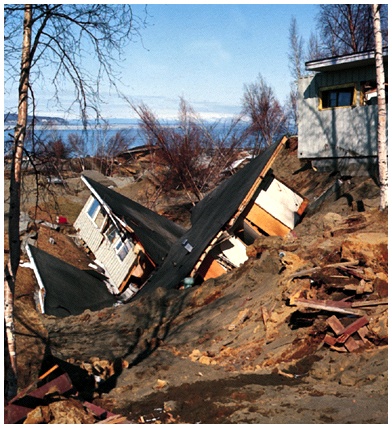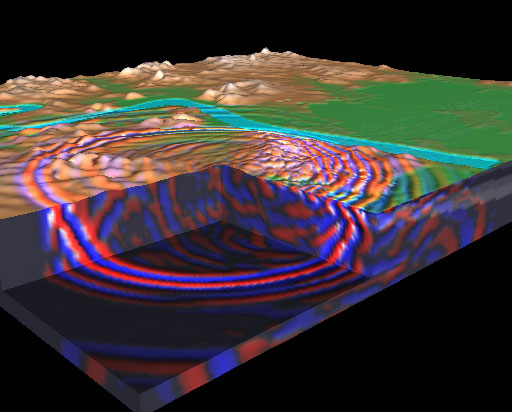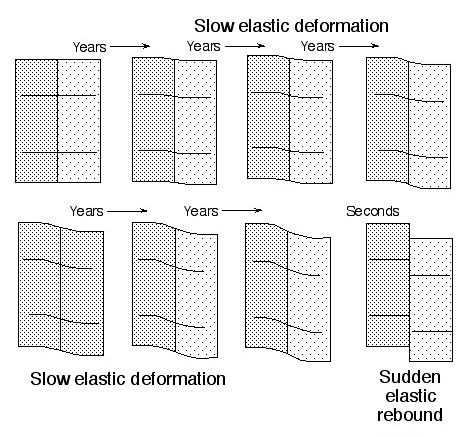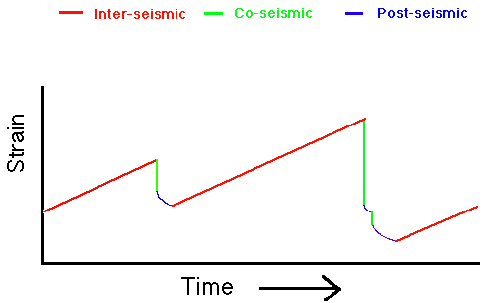
Earthquakes and the Seismic Cycle

I. What is an earthquake?
II. The seismic "cycle"
III. Other slip phenomena
I. What is an earthquake?
An earthquake is caused by a sudden release of strain in
the earth's interior (meaning the crust or mantle). The sudden release of
strain occurs because the strength of the straining material is exceeded by
the strain that has accumulated within that material. For example, along a
fault that is locked by friction, fault rupture occurs when the accumulated
strain exceeds the frictional forces that prevent fault slip.

Simulation of earthquake waves moving away from a
hypothetical earthquake hypocenter. "Body" waves travel through the
earth's interior in all directions away from the rupture. "Surface"
waves move along the earth's surface. Photo is courtesy of
Queensland University Advanced Centre for Earthquake Studies, Australia.
The term "earthquake" refers to the ground vibrations that
are induced by energy released into the earth during fault rupture. These
vibrations are known as seismic waves. Seismometers operating
around the globe on a continuous basis record the tiny displacements of the
surface that are caused by seismic waves. The seismometer records the arrival
time of these displacements and their amplitude, both of which provide useful
information about earthquake location and magnitude.
Why are earthquakes relevant to a course about building
mountains ? Non-volcanic topography is almost always created by slip
along normal and reverse faults and that slip is almost always manifested
as earthquakes. More details about the process are provided below.
Before you begin to study the earthquake cycle, it is first
important to have some basic information about earthquake terminology, seismic
waves, and assorted techniques for locating earthquakes and learning about
their key characteristics.
Please study the tutorial below and in particular, focus on the following parts of the site.
- How to read a seismogram
- Where was that earthquake?
- How strong was that earthquake?
II. The seismic "cycle"
Although not all earthquakes are caused by sudden slip along a fault, most of them are. The general concept you must keep in mind is that faults are relatively planar (flat) fractures in the crust along which rocks on either side of the fault move in different directions. Because fault surfaces are "rough", rocks that meet along a fault do not slide freely past each other, but are instead locked for long periods by friction along the fault. Over decades to millenia, strain builds up within the rocks that are separated by the fault as their movement is prevented by along-fault friction. At some point, the amount of strain exceeds the frictional forces that are preventing slip. The fault ruptures and rocks on either side of the fault slide rapidly as the pent-up strain is relieved. The moment of rupture is when the earthquake occurs. For obvious reasons, the earthquake cycle is frequently referred to as a "stick-slip" process - long periods of "stick" are followed by a short period of "slip", and the process then repeats itself.
The seismic "cycle" refers to the observation that earthquakes repeatedly rupture a given part of a fault. The term "cycle" does not however imply that earthquakes are a periodic or regularly repeating event (in other words, "cycle" does not imply that earthquakes are a natural phenomenon that have clocklike behavior like the rising and setting of the sun).
The seismic cycle can be divided into three periods, consisting of inter-seismic slip, co-seismic slip, and post-seismic slip. Two of these three phases are illustrated by the following figure, namely, the period of slow accumulation of elastic strain that coincides with frictional locking of a fault between earthquakes (the interseismic phase), and the sudden rupture that is the earthquake (the coseismic phase). The term "elastic" refers to a particular type of rock deformation, namely deformation that can be "recovered" at a future point. Elastic materials have "memory" of their original shape. If their shape is changed because a force is imposed on them, they will return to their original shape if the force is removed. A rubber band is an excellent example of an elastic material. So are rocks, provided that their temperatures aren't too high.

Inter-seismic elastic strain accumulation
occurs for long-periods, until the elastic strain build-up exceeds the ability
of the frictional forces that lock a fault to prevent slip. The earthquake
occurs at the moment that the fault ruptures, at which point the rocks on
either side of their fault "recover" their original undeformed shapes. Another
way to view the process is that there are two tectonic plates moving steadily
in opposite directions at the edges of the shaded and dotted areas. Since
the fault that separates them is locked by friction, rocks closer to the fault
are not free to move with their respective plates and so they accumulate a
slip "deficit" with respect to their plates. At the moment of the earthquake,
these rocks "catch" up to their respective plates by recovering their original
shape. At that moment, all of the plate movement has become concentrated
along the fault!
The third phase of the seismic cycle corresponds to a period of minutes
to years after an earthquake when the crust and fault both "adjust" to the
modified state of crustal stress caused by an earthquake. During the
"post-seismic" period, at least two distinct processes give rise to additional
movement of the crust. One consists of additional slip, usually minor, along
the fault. Some of this additional slip is due to earthquake aftershocks on
the ruptured fault. After large earthquakes, deeper regions of the crust "flow"
in response to changes in crustal stress caused by the preceding earthquake,
much like water flows away from areas of high pressure so as to re-equalize
pressure everywhere within a body of water. Such flow occurs in rocks that were
too hot to fracture during the earthquake.
More details about all three parts of the earthquake cycle are given
below.

Figure: The seismic cycle. Shows the history of strain accumulation and release along a single fault patch.
Suppose that we have a 100-km-long section of a fault that is known to rupture in earthquakes.
Inter-seismic slip refers to the strain that accumulates steadily (the red lines above) between the earthquakes that irregularly but repeatedly rupture the fault. In general, measurements of the yearly motion of two sites that are located immediately across the fault from each other will show little or motion. Why? Because the fault is locked between earthquakes and crust adjacent to the fault thus cannot slip! In contrast, motion measured between two sites that are across the fault from one another, but are separated by distances of many tens of kilometers will show that the sites move significantly relative to each other. Why? Because far from the fault, crust must slip relative to crust across the fault or no strain would accumulate in the crust closer in to the fault.
Co-seismic slip refers to the slip that occurs at the instant of the earthquake (green lines above). Interestingly, measurements of co-seismic motion for site near and far from the fault show just the opposite pattern as exhibited for inter-seismic motion! Why? Because during an earthquake, the highly strained rocks near the fault rupture, which moved little or not at all during the inter-seismic period, are permitted to slide back to a less-strained state. In contrast, sites on crust far from the rupture zone were moving steadily during the inter-seismic period and thus accumulated little or no strain. During an earthquake, they thus move little or not at all as they slide into their "less-strained" state.
Post-seismic slip refers to slip that occurs in the days, months, and sometimes years after an earthquake (blue lines above). Such slip occurs for a variety of reasons and typically differs from the steady inter-seismic slip described above (although in some sense, post-seismic slip is simply a subset of inter-seismic slip). A fault that has experienced a significant rupture often continues to accommodate significant slip after the rupture. However, the post-seismic slip eventually decays back to the steady inter-seismic slip.
The cumulative motion along a fault patch through many seismic cycles is responsible for the often significant displacements that can occur along a fault. For example, the San Andreas fault in central California has accommodated 315 kilometers of offset during its lifetime. For a typical co-seismic slip of 5 meters and a 200-year average inter-seismic period, how long would slip have had to continued to generate this much offset?
Slip period = (315 km x 1000 m/1 km) / 5 meters * 200 years per cycle
= 63000 cycles * 200 yrs/cycle = 12.6 million years!
In fact, in central California, evidence for slip along
the San Andreas fault suggests that it began 10-15 million years ago.
III. Other slip phenomena
Clearly, earthquakes are a key process in accommodating the relative motions of plates along their plate boundaries. However, do they accommodate all plate motion or are other processes also involved? Plate velocity models tell us how plates move on a yearly basis to an accuracy of a few percent. We can thus compute how much strain should be accumulating along plate boundary faults and how much energy earthquakes should be releasing if they were the only process that accommodated plate slip.
We now know that far too few earthquakes have occurred this century to account for all of the slip that is occurring along plate boundaries. In fact, earthquakes appear to account for only about 30% or less of plate slip! This requires that other processes accommodate slip along faults, too.
Steady slip along a fault's surface without any buildup of strain is occasionally observed (most notably along parts of the San Andreas fault in central California). This process (fault creep) indicates that frictional forces or geometric irregularities that normally lock a fault are minimal or absent.
A locked fault will sometimes release strain that has accumulated within the adjacent crust by rupturing over a period of hours or days instead of rupturing over a period of seconds, as occurs during earthquakes. When the "slow" or "silent" rupture events occur, the resulting energy release is difficult or impossible to detect with conventional seismometers, which do a poor job of detecting slow ground motion. However, there is compelling evidence that such slow-rupture processes exist and our ability to study them has improved dramatically in the past few years as high-precision geodetic instruments that are capable of measuring ground displacements on all time scales have been deployed in many active fault zones. What fraction of plate slip these slow-rupture processes accommodate is presently unknown.
IV. Mountain building and earthquakes: Some simple geometrical calculations
How long does it take to raise a mountain along an inclined fault where the hanging wall is thrusting above the foot wall?
This is a simple geometrical exercise similar to the one posed in Lecture 3. If we assume that 5 meters of horizontal slip accumulates every 200 years (equivalent to 25 millimeters per year of horizontal strain accumulation) and that the strain is released in earthquakes along an inclined fault, we can easily compute how long it will take for vertical uplift of a given amount to occur.
Suppose we wish to compute how long it will take for 3000 meters (roughly 10,000 feet) of uplift to occur. Clearly, the time it requires is equal to the uplift divided by the rate at which uplift occurs.
Uplift time = total uplift / rate of uplift
To compute how horizontal strain that accumulates at a known rate (5 meters per 200 years in this example) translates into vertical uplift rate, we note that it is related to the tangent of the dip of the fault (see figure in Lecture 3) as follows
uplift rate = horizontal rate * tangent (fault dip)
where
horizontal rate = slip during average earthquake / earthquake recurrence interval
Suppose that uplift occurs along a shallow fault dipping 10 degrees from horizontal. Then,
uplift time = 3,000 m /( ( 5 m / 200 yrs) * tan(10) ) = 680,000 years
For a steeper fault (30 degrees), uplift of 3,000 meters occurs even more rapidly, in only 210,000 years.
Thus, for rapid convergence rates and even shallow fault dips, significant topographic relief can appear in only several hundred thousand years - a geological instant! Of course, these calculations ignore the important effects of erosion and downward flexure of the lithosphere under the load of a growing mountain, both of which slow the rate at which a mountain can grow. We shall consider these effects more in future lectures.